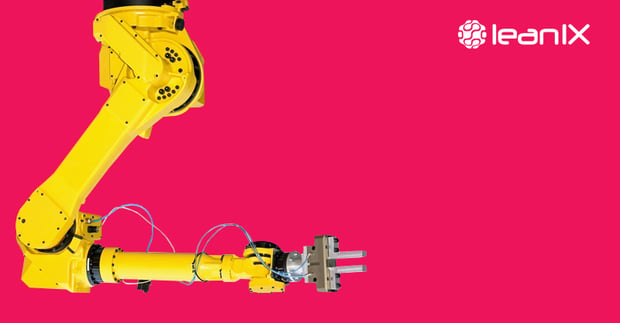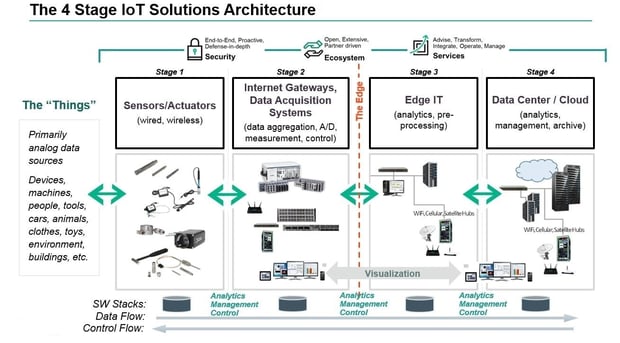
IoT brings innumerable opportunities to the business world. Multiple statistics show the grave economic impact that IoT will bring, but not many organizations are thinking of truly creative ways to capitalize off of the incoming surge in invaluable data. Businesses can now track the usage of their products, and sell services to go along with them. The IoT opens far more opportunities than most organizations are pursuing today. For instance, organizations that sell products can attach sensors to them to track the usage of the end-user. This usage can turn into another stream of revenue.
Your organization will need a firm infrastructure to support the new connections from IoT – an agile infrastructure that can scale on demand. How can your infrastructure support IoT?
The four-stage architecture of an IoT system
Stage one consists of wireless sensors and actuators. Stage two includes the addition of sensor data aggregation systems and analog-to-digital data conversion. In Stage 3, edge IT systems perform pre-processing of the data before it moves on to the data center or cloud. Finally, in Stage 4, the data is analyzed, managed, and stored on traditional back-end data center systems.

Source: TechBeacon
Stage 1: Sensors and Actuators
Sensors collect data from the environment or object under measurement and turn it into useful data. Contrarily, an actuator transforms electrical data into interesting, useful energy. For example, on a cell phone, the camera and microphone are sensors whereas the speakers and screen are actuators. Actuators can also intervene to change the physical conditions that generate the data. An actuator can shut off a power supply, adjust an air flow valve, or move a robotic gripper in an assembly process. This stage of the IoT is expanding rapidly, with robotic camera systems, water level detectors, home voice controllers, air quality sensor, smart baby monitoring devices etc.
All of these devices will collect user data, including sign-on times, level and hours of usage, location statistics, etc. As these devices produce an avalanche of data, it will be important to your organization to choose which data is useful to you and which can be ignored. Enterprises can expect a surge in data velocity, and with that surge, organizations will benefit from moving their data into the cloud. Some data should be processed immediately i.e.: time-sensitive data – threat detection, immediate crash statistics, abrupt shutdowns, etc. Otherwise, data that will undergo deep processing and analyzation should be pushed directly to the cloud, to avoid network clutter.
Stage 2: The Internet Gateway
Data collected from the sensors or actuators is very raw. This data has to be aggregated and converted into digital streams for further data processing. In order to carry out this data processing, it is imperative to use a data acquisition system (DAS or DAQ). Data acquisition is the process of sampling signals that measure real world physical conditions and converting the resulting samples into digital numeric values that can be manipulated by a computer. Data acquisition systems typically convert analog waveforms into digital values for processing.
The DAS connects to the sensor network, aggregates outputs, and performs the analog-to-digital conversion. The Internet gateway receives the aggregated and digitized data and routes it over Wi-Fi, wired LANs, or the Internet, to Stage 3 systems for further processing.
Stage 3: Edge IT Systems
In the previous stages, IoT data has been digitized and aggregated – it is now time to present the data to the IT department. In any event that the data requires further processing before it enters the data center, you’ll need an edge IT system. Edge IT processing systems offer computation and data processing at the edge of the network where IoT connects the physical world to the Cloud. A fundamental part of it is the strong and seamless integration between IoT and Cloud; between the physical world and the world of computation.
Edge Computing applications use the processing power of IoT devices to filter, pre-process, aggregate, or score IoT data. The applications also use the power and flexibility of Cloud services to run complex analytics on those data and, in a feedback loop, support decisions and actions about and on the physical world.
IoT data can easily overspend network bandwidth and overwhelm your data center resources, so it is best to have edge IT systems capable of performing analytics as a way to lessen the labor on the core IT infrastructure. Without diversified processing centers, your company also runs the risk of security concerns, stressed networks, and computational lag. Instead of passing raw data to be collected and eventually analyzed in bulk, pre-processing the data, gathering meaningful results, and admit only the actionable data to the data centers.
Consider using machine learning techniques at the edge to scan for anomalies and impending maintenance issues that will require immediate attention. From there you can trigger visualization technology to present the information in easily-digestible maps and graphs. All of this without stressing your core IT infrastructure.
Stage 4: The Data Center and Cloud
Data that requires more thorough processing, and does not require immediate feedback, should be forwarded to the physical data center or supporting cloud-based systems. In the data center or the cloud, more powerful IT systems can analyze, manage, and securely store data. Once data reaches this stage, it takes a bit longer to receive results, but the results will carry a more in-depth analysis than the previous 3 steps. This 4-tier approach to IoT infrastructure and processing will inspire new levels of collaboration in your supporting teams. IT professionals will work closely with OT professionals, both bringing their domain expertise into data processing and analyzation. Domain experts can teach IT professionals to identify sources of potentially valuable data.
IoT promises to reshape entire industries in unprecedented ways, is your organization prepared? Learn Jason Bloomberg's tips for transforming Enterprise Architecture for digital empowerment.
/EN-Pharma-BCM_Poster_Resource_Page_Thumbnail.png?width=140&height=99&name=EN-Pharma-BCM_Poster_Resource_Page_Thumbnail.png)
/EN-WP-SuccessKit_Pharma_Industry-Resource_Page_Thumbnail.png?width=140&height=99&name=EN-WP-SuccessKit_Pharma_Industry-Resource_Page_Thumbnail.png)
/EN-Pharma-24Key_Poster_Resource_Page_Thumbnail.png?width=140&height=99&name=EN-Pharma-24Key_Poster_Resource_Page_Thumbnail.png)